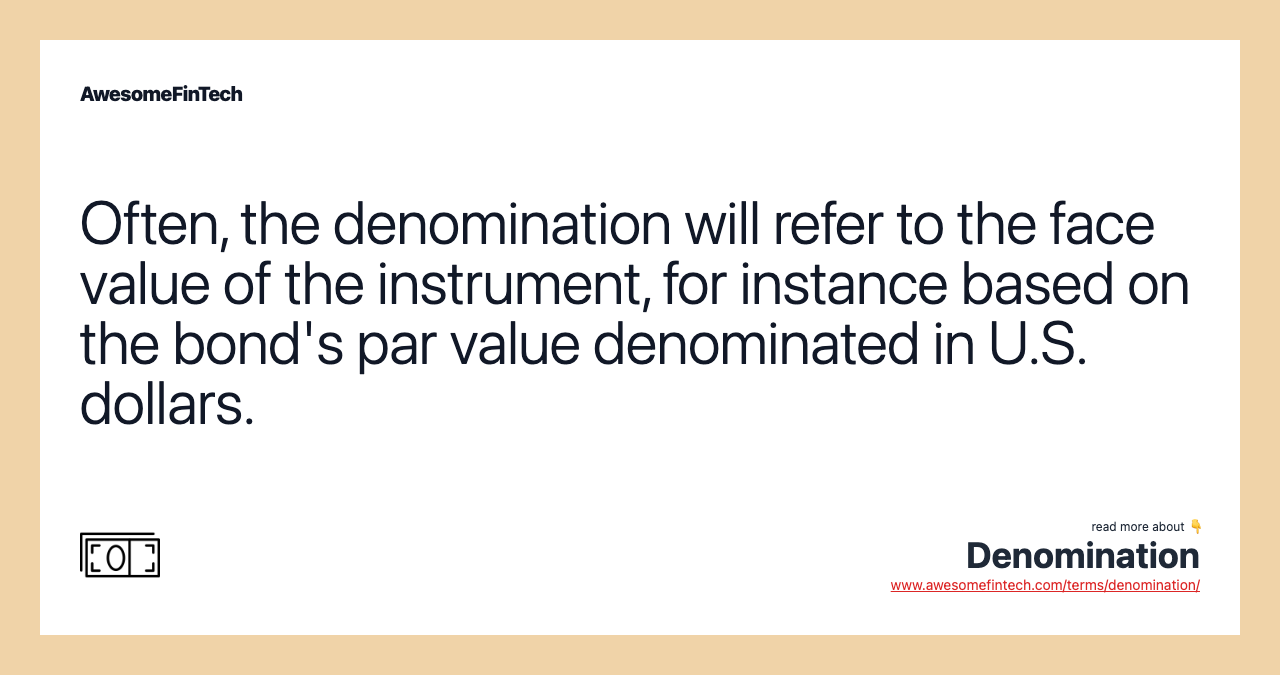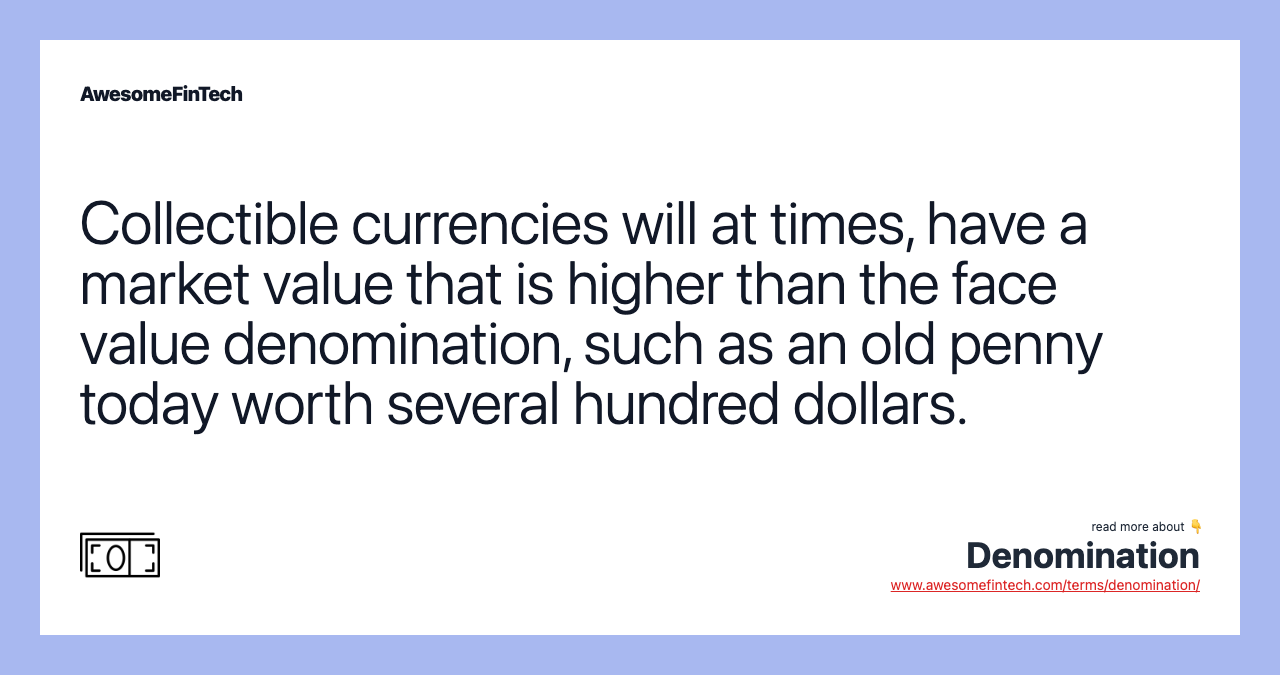Denomination
A denomination refers to the units classification for the stated or face value of financial instruments such as currency notes or coins, as well as for securities, bonds, and other investments. The denomination value of such a fixed-income security is often referred to as its “face value” because it appears on the front, or face, of the financial instrument. In the United States, currency notes dispensed by most automated teller machines (ATMs) are only available in certain denominations. Consequently, although the face value maintains their worth at 25 cents, the market value may be higher, based on the price of silver, the melt value of silver, the condition of a specific coin, and the date and mint involved. Often, the denomination will refer to the face value of the instrument, for instance based on the bond's par value denominated in U.S. dollars. Collectible currencies will at times, have a market value that is higher than the face value denomination, such as an old penny today worth several hundred dollars.

What Is a Denomination?
A denomination refers to the units classification for the stated or face value of financial instruments such as currency notes or coins, as well as for securities, bonds, and other investments.
The denomination can therefore be used to quote the base currency in a forex transaction, or the quoted currency in a financial asset. This use of the term helps define the acceptable payment in trades and the monetary unit in which it is priced, for example when indicating U.S. dollar-denominated bonds issued by a foreign government.



Understanding Denomination
Most often, a denomination is a unit of value, or numeraire, given to money or currencies like coins and notes, as well as other financial instruments that maintain set values, such as government-issued bonds. The denomination value of such a fixed-income security is often referred to as its “face value” because it appears on the front, or face, of the financial instrument.
In the United States, currency notes dispensed by most automated teller machines (ATMs) are only available in certain denominations. As an example, some ATMs offer $20 bills and $100 bills, while others might provide $10 and $50 notes. In a trade transaction, an exporter based in Europe may invoice the buyer in U.S. dollars, making the transaction U.S. dollar-denominated. While most commodities were quoted in terms of the dollar, beginning in 2011, commodities such as crude oil could receive quotes in other currency denominations, such as the euro.
Some foreign entities will issue securities denominated in a different currency from their own. For instance, the government of Argentina has issued U.S.-dollar denominated sovereign debt, and certain non-U.S. corporations issue shares denominated in dollars.
Par Values as Denominations
The denomination affixed to a bond or other fixed-income investment is equal to the bond's par value, which is the amount paid upon maturity. One may purchase bonds in a variety of denominations, ranging from $50 to $10,000. When one buys a mutual bond, it is sold for an amount below the marked denomination because the difference between the sales price and the value at maturity serves a function similar to the interest earned in other investment vehicles.
Other types of securities are also issued with par values; however, the actual par value on a share of stock, for instance, is not an accurate assessment of the security's importance in the marketplace. The par value here instead represents a minimum value for the holding. When issuing common stock, corporations actually issue them with a face value as little as zero or one cent. This pricing convention allows them to avoid legal liabilities they may expose themselves to if they listed the stock at a higher price.
Denominations and Nomenclature
Nomenclature is the act of applying a name to an item, and many currencies carry not only the official denomination but also a nickname. As an example, the Canadian dollar (CAD) carries the nickname of the "loonie" because it has the image of a loon bird on one side. The American $100 bill is known as a "Benjamin" because it carries the picture of Benjamin Franklin.
Real World Example
Some individual pieces of currency have a higher retail market value than their officially marked denomination. These currencies are collectible and sought after by hobbyists and those looking for an alternative investment.
For example, some U.S. quarters produced between 1932 and 1964 comprised 90% silver content. Consequently, although the face value maintains their worth at 25 cents, the market value may be higher, based on the price of silver, the melt value of silver, the condition of a specific coin, and the date and mint involved. This difference between the denomination and the melt value ultimately led to a change in the materials used to produce quarters.
Related terms:
Automated Teller Machine (ATM)
An automated teller machine is an electronic banking outlet for completing basic transactions without the aid of a branch representative or teller. read more
Base Currency
The first currency quoted in a currency pair on forex. It is also typically considered the domestic currency or accounting currency. read more
Bond : Understanding What a Bond Is
A bond is a fixed income investment in which an investor loans money to an entity (corporate or governmental) that borrows the funds for a defined period of time at a fixed interest rate. read more
CAD (Canadian Dollar)
CAD, nicknamed the "loonie," is the currency abbreviation or currency symbol used to denote the Canadian Dollar. read more
Coupon Equivalent Rate (CER)
The coupon equivalent rate (CER) is an alternative calculation of coupon rate used to compare zero-coupon and coupon fixed-income securities. read more
Death Put
A death put is an option added to a bond that guarantees that the heirs of the deceased can sell it back to the issuer at par value. read more
Discount
In finance, a discount refers to a situation when a bond is trading for lower than its par or face value. These include pure discount instruments. read more
Euro
The European Economic and Monetary Union is comprised of 27 member nations, 19 of whom have adopted the euro (EUR) as their official currency. read more
What Is a Eurodollar Bond?
Eurodollar bonds are important funding sources for international entities, denominated in U.S. dollars but issued and held overseas. read more
Face Value
Face value is the nominal value or dollar value of a security stated by the issuer, also known as "par value" or simply "par." read more